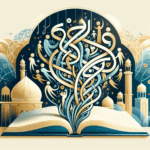The Arabic Alphabet and Its Global Influence
The Arabic alphabet is more than just a set of symbols used for writing languages; it’s a cultural bridge that has connected various parts of the world for centuries. This script not only plays a vital role in the daily lives of millions but also influences global cultures, languages, and art. Let’s explore the fascinating world of the Arabic alphabet and its global impact.
Table of Contents
1. Introduction to the Arabic Alphabet 🌍
2. Historical Significance and Spread 🕰️
3. The Aesthetic Appeal of Arabic Calligraphy 🎨
4. Global Influence on Languages and Scripts 🗣️
5. Conclusion: A Timeless Script 🌟
6. FAQs 🤔
Introduction to the Arabic Alphabet 🌍
The Arabic alphabet consists of 28 letters and is written from right to left. Unlike the Latin alphabet, it does not have distinct upper and lower case forms. Its unique characteristics, such as the cursive style where letters often connect to each other, contribute to its visual beauty. But beyond aesthetics, the Arabic alphabet is a key component of cultural identity for millions across the globe.
Historical Significance and Spread 🕰️
The Arabic alphabet originated in the 4th century CE and quickly spread with the expansion of Islam. As the Islamic empire expanded, so did the use of the Arabic script, becoming the writing system for a multitude of languages, including Persian, Urdu, and Kurdish. This widespread adoption was not just a result of religious influence but also due to the trade and intellectual exchanges of the time.
The Aesthetic Appeal of Arabic Calligraphy 🎨
Arabic calligraphy is celebrated worldwide for its artistic expression. The script has been used to adorn everything from mosques to modern art galleries. Artists and calligraphers create visually stunning works by manipulating the script’s forms into intricate patterns and designs. This art form has transcended cultural boundaries, influencing Western art and design, and is often seen in fashion and architecture.
Global Influence on Languages and Scripts 🗣️
The influence of the Arabic alphabet extends beyond art; it has left an indelible mark on other languages and scripts. For instance, the Swahili language, spoken in East Africa, incorporates many Arabic loanwords. Similarly, the Maltese language, despite being based on a Latin script, has significant Arabic influences due to historical interactions.
Conclusion: A Timeless Script 🌟
The Arabic alphabet is more than just a writing system; it is a testament to cultural exchange and historical connectivity. Its global influence is a reminder of the interconnectedness of human societies. Whether through language, art, or history, the Arabic script continues to inspire and connect people worldwide.
FAQs 🤔
1. How many letters are in the Arabic alphabet?
The Arabic alphabet consists of 28 letters.
2. Why is Arabic written from right to left?
The right-to-left direction is a characteristic of several Semitic scripts, including Arabic, due to historical and practical reasons of writing with the right hand.
3. What are some languages that use the Arabic script?
Languages such as Persian, Urdu, and Kurdish use the Arabic script, with some modifications.
4. Is Arabic calligraphy difficult to learn?
While it can be challenging due to its intricate designs, learning Arabic calligraphy can be rewarding and offers insight into the culture and history behind the script.
5. How has the Arabic alphabet influenced other cultures?
The Arabic alphabet has influenced other languages, art forms, and even modern design, showcasing its versatility and cultural significance.





